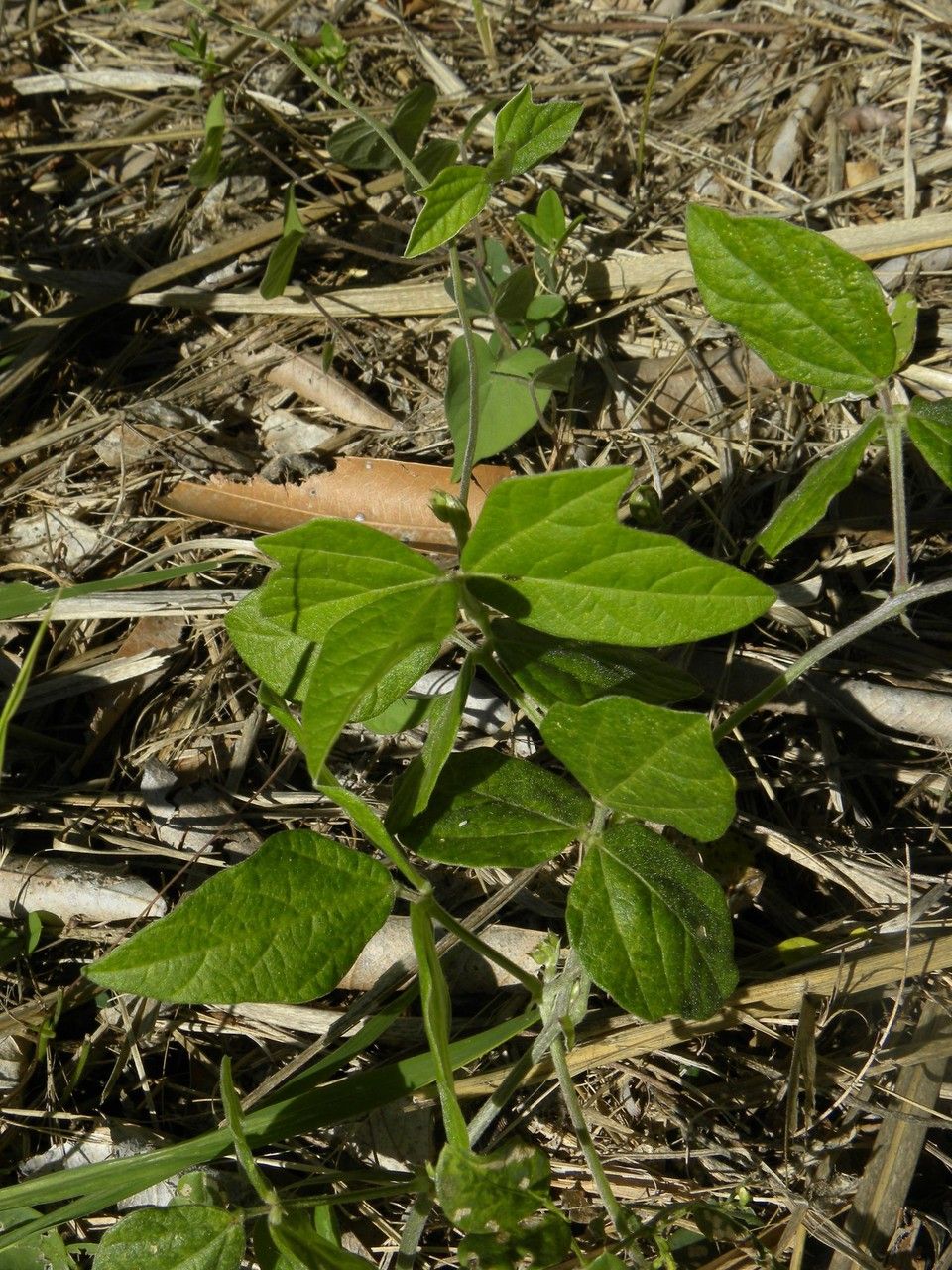Purple-flowered bush bean
macroptilium atropurpureum
Also known as: ["Bush bean","Purple bean"]
Overview
A leguminous plant native to tropical regions, known for its purple flowers and nitrogen-fixing capabilities.
Benefits & Perks
["long-flowering","wildlife attractant (bees, butterflies, birds)","drought tolerant"]
Botanical Classification
| Phylum: | Magnoliophyta |
| Class: | Magnoliopsida |
| Order: | Fabales |
| Family: | Fabaceae |
| Genus: | Macroptilium |
| Botanical Name: | Macroptilium atropurpureum |
Plant Characteristics
Basic Information
- Category: Flowers
- Suitable Location: outdoor garden bed in temperate to tropical climates
- Suitable For:
- Is Weed: No
- Allergenicity: low
Environmental Needs
- Climate: {"temperatureRange":"10–35°C"}
- Hardiness: {"zones":"9–11"}
- Misting: rarely required, only if ambient humidity is very low
- Drainage: Fast-draining to prevent root rot.
- Soil Type: Well-draining loamy soil with added organic matter.
Maintenance Level
- Maintenance Level: moderate
- Toughness Level: moderate
- Pruning Frequency: Light pruning every 2–3 months; heavy pruning annually after flowering.
- Pruning Intensity: Moderate; remove up to one-third of growth if needed.
Care Details
Ideal Sunlight Coverage:
Full sun (6–8 hours/day); tolerates partial shade but blooms best in direct light.
Sunlight Tolerance Tips:
Acclimate plants gradually to full sun if moved from shade; protect from intense midday sun in hot climates; ensure good air circulation to prevent scorching.
Care Requirements
Care Difficulty
easyeasy
Sunlight
full sun to partial shade
Rotate plant for even growth; use shade cloth in extreme heat; avoid sudden light changes.
Watering
every 7–10 days during active growth, reduce in winter
Water thoroughly but infrequently; ensure good drainage; avoid wetting foliage to prevent fungal diseases.
Soil
well-drained, loamy soil with moderate organic content
pH: Slightly acidic to neutral (6.0–7.0).
Avoid heavy clay soils; ensure soil is loose and crumbly; test pH annually.
Temperature
Prefers warm temperatures (65–85°F/18–29°C); sensitive to frost.
Protect from frost; avoid sudden temperature swings; maintain consistent warmth during growth.
Fertilizing
every 4–6 weeks during growing season
Fertilize sparingly to avoid leggy growth; flush soil occasionally to prevent salt buildup; apply after watering to avoid root burn.
Propagation
Methods
Stem cuttings or seed; stem cuttings root easily in warm conditions.
Step-by-Step Propagation Guide
- Take 4–6 inch cuttings.
- Remove lower leaves.
- Dip in hormone.
- Plant in medium.
- Keep moist and warm.
Best Time: Spring or early summer when temperatures are warm and growth is active.
Environment
Warm (70–80°F/21–27°C), high humidity, and bright indirect light.
Medium
Well-draining mix of perlite and peat moss or cactus mix.
Hormone
Optional but recommended for faster rooting.
Timeline
Roots in 2–4 weeks; establish in 8–12 weeks.
Tools Needed
Pruning shears, rooting hormone, small pots, well-draining medium.
Quick Tips
Use healthy parent plants; maintain humidity with a plastic cover; keep out of direct sun.
Pruning & Repotting
Pruning Guide
Method
Pinch back tips for bushiness; cut stems just above a leaf node.
Pruning Plan
Prune to maintain shape, encourage bushier growth, and remove dead or diseased stems.
Tools
Pruning shears, sterilizing solution, gloves.
Checklist
Sterilize tools; prune dead/diseased stems; shape plant; clean up debris.
Repotting Guide
Best Season
Spring, before new growth begins.
Pot Size
Increase pot size by 2–3 inches in diameter.
Method
Remove plant gently; trim roots if needed; repot in fresh soil with good drainage; water lightly.
Suggestions
Repot every 2–3 years or when roots fill the pot; beneficial for container-grown plants.
Checklist
Check root bound status; prepare new pot; use fresh soil; water after repotting.
Advanced Care Tips
Watering Mastery
Watering Checklist
Check soil moisture; water deeply; ensure drainage; avoid wetting leaves.
How to Apply Water Properly
Water at the base of the plant, focusing on the root zone; water until it drains from the bottom; avoid overhead watering.
Watering Schedule Tips
Water deeply once the top inch of soil is dry; reduce frequency in winter to prevent root rot.
Soil Improvement
Add perlite or sand for drainage; incorporate compost for fertility; ensure aeration with organic matter.
Temperature Stress Management
Signs of Temperature Issues
Wilting, leaf drop, or cessation of flowering in extreme heat or cold.
Cold Stress
Stem damage, leaf discoloration, and potential death in temperatures below 50°F (10°C).
Solution: Move to a sheltered location; cover with frost cloth; avoid watering before cold nights.
Hot Stress
Leaf scorch, reduced flowering, and wilting in prolonged high temperatures.
Solution: Provide afternoon shade; increase watering; use mulch to retain soil moisture.
Fertilizing Guide
Fertilizing Checklist
Check fertilizer type; dilute properly; apply during active growth; avoid winter feeding.
Fertilizing Method
Use balanced liquid fertilizer diluted to half strength every 4–6 weeks during growing season; avoid fertilizing in winter.
Common Problems & Solutions
Toxicity Warning
Cats
Slightly ToxicCats are susceptible to mild gastrointestinal irritation if they consume Macroptilium atropurpureum seeds or young pods. The toxic compounds can cause discomfort but are not typically life-threatening.
⚠️ Symptoms:
🌿 Toxic Parts:
⚡ Toxic If:
if eaten
Dogs
Slightly ToxicDogs may experience mild gastrointestinal upset if they ingest significant amounts of Macroptilium atropurpureum seeds or young pods. The lectins present can irritate the digestive tract.
⚠️ Symptoms:
🌿 Toxic Parts:
⚡ Toxic If:
if eaten
Humans
Slightly ToxicMacroptilium atropurpureum contains lectins and other compounds that can cause mild gastrointestinal distress if ingested in significant quantities. The toxic effects are generally not severe but can be problematic for individuals with sensitive digestive systems.
⚠️ Symptoms:
🌿 Toxic Parts:
⚡ Toxic If:
if eaten
Frequently Asked Questions
Q: Is Macroptilium atropurpureum edible?
A: The plant is primarily ornamental, and its edibility is not well-documented.
Q: How does this plant benefit the garden?
A: It fixes nitrogen in the soil and attracts pollinators like bees and butterflies.
Q: Does it require full sun?
A: Yes, it thrives in full sun but can tolerate partial shade.
Quick Reference
| Family: | Fabaceae |
| Care: | easy |
| Light: | full sun to partial shade |
| Water: | every 7–10 days during activ |
Get Expert Care Tips
Download the Plantious app for personalized care reminders and plant identification!
Google Play App Store








